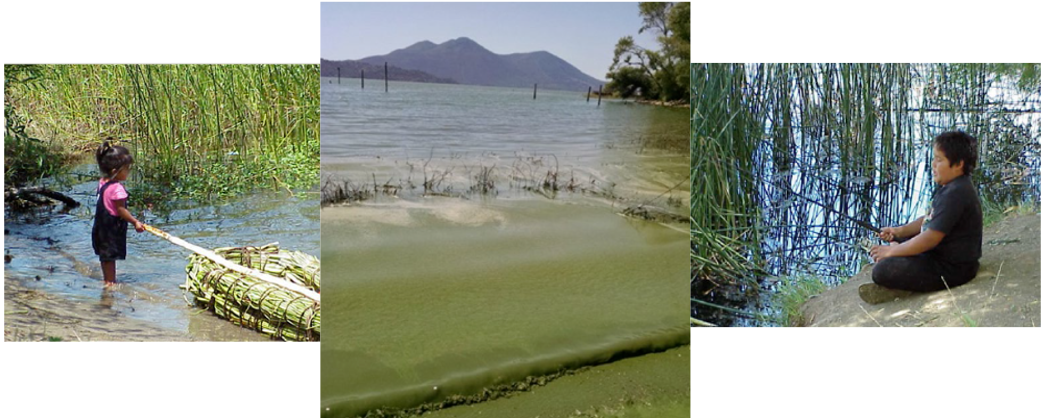Impacts of climate change on the Big Valley Band of Pomo Indians
Warming air temperatures, variable precipitation, drought, wildfire, warming lake temperatures, harmful algal blooms, reduction of fish, bird and animals, as well as other stressors are impacting Tribal livelihood, culture, and traditions.
The Big Valley Band of Pomo Indians of the Big Valley Rancheria of California is a self-governing, federally recognized Tribe of Pomo Indians living on the shores of Clear Lake in Lake County, California. Their ancestors, the Xa-Ben-Na-Po Band of Pomo Indians, inhabited the Clear Lake area for over 11,800 years. Though the Rancheria sits on 350 acres today, traditional tribal lands extend much farther. Big Valley Pomo rely heavily on Clear Lake and the resources surrounding it for subsistence and livelihood, as well as for important cultural and spiritual practices.
Over the past century air temperatures, which are linked to impacts on human and ecosystem health, have increased at Big Valley. Rising temperatures also strain energy demand and infrastructure. Warmer air temperatures along with a lack of rainfall over time stresses vegetation, creating susceptibility to pests, disease, and death. The increase in dead vegetation then increases wildfire risk for the Tribe. The effects on vegetation also reduce the availability of materials and resources important to the Tribe for various cultural and spiritual uses, such as tules.
Below: Scenes from Big Valley: a child at Tule Boat Festival, HABs bloom at Clear Lake, a child fishing in the tules (Source: Big Valley EPA).

Warming temperatures and changing precipitation patterns are also associated with increased harmful algal blooms (HABs) in Clear Lake. Tribal members report that HABs have become much more prevalent over the last couple of decades. HABs are regularly seen in Clear Lake and produce levels of cyanotoxins that are harmful to humans, fish and animals. In 2021, as a result of high levels of HABs, many parts of the lake were unsafe for contact most of the year, disrupting many uses and activities.
Rain has been variable at the Big Valley Rancheria, particularly in the last thirty years. The Tribe has experienced years of extremely high and low rainfall. High rainfall events cause a sharp increase of surface water flow into Clear Lake, leading to erosion, sediment deposition into the lake, and decreased water quality. Heavy rains affect infrastructure at Big Valley. Many tribal members live in mobile homes, which are particularly susceptible to flooding. The Tribe has identified increased mold growth after heavy rain events as an impact of climate change.
The Increasingly variable precipitation the Tribe has experienced has also led to drought. Drought has impacted resources, lake water quality, and caused stress to vegetation. Increased reliance on groundwater to support agriculture in the face of drought reduces the water in streams where Clear Lake Hitch, an endemic and culturally significant fish, spawn. Hitch monitoring reveals that not only are there fewer adult Hitch, but the number of juveniles is declining. Monitoring completed in 2021 found no juvenile Hitch. Additionally, Elders of the Big Valley Tribe have seen Hitch numbers decline in their lifetime. The loss of this fish impacts the community, the history, and the culture of the Pomo people. Restoring their habitat and numbers will also improve the health of Clear Lake overall as they are also an important food source for numerous birds, fish, and other wildlife.
Warming lake waters are associated with lower levels of dissolved oxygen (DO) in water, which poses risks to aquatic species. DO is the most important health indicator of a water body and its capacity to support a balanced aquatic ecosystem of plants and animals. The Upper Arm of Clear Lake, where the Tribe is located has shown lower DO and increasing frequencies of hypoxia since 2000.
The Tribe is seeing fewer quail, otters, turtles, flicker, red-wing blackbirds and other animals that are important to the Tribe. These species have diminished due to the cascading impacts of climate change on their habitat.
Climate change has exacerbated food insecurity for the Tribe. There are fewer native wildlife species on which the Tribe has relied on for food such as Indian potato, clover, acorn, pine nuts, edible mushrooms, fish, clams, prickly sculpin, crayfish, and tules. Tule plants are at risk as a result of the changing climate and from area development. Roughly 85% of the Clear Lake shoreline tules have been lost already. Tules are an important plant for the Tribe and are used to build boats, for weaving, in ceremonies, as a food source, and for various household uses.
The 459,153-acre Mendocino Complex Fire in 2018, which burned for over 3 months, directly impacted the Big Valley Tribe. Wildfires pose unique and heightened challenges to Tribes, given their relationships to the land. Further, non-Native government officials often the lack an understanding of tribal customs and priorities. Historically the Pomo would have conducted cultural burns, low intensity burns that reduce the risk of wildfire by consuming dead wood and other fire fuels on forest floors.
The Big Valley Band of Pomo Indians has been living alongside Clear Lake and managing their ecosystem since time immemorial. The health of the Big Valley Band of Pomo Indians cannot be separated from the health of their environment. Increasing temperatures, variable rainfall, HABs, wildfires, exposure to smoke, pesticides, loss of important species, all impact the Tribe. The Big Valley Band of Pomo Indians is working both internally and with outside agencies to help to restore a balance and provide a more sustainable and certain environment for future generations.
This summary report and a more detailed report are available for download below.
